Table of Contents
- Introduction
- Editor’s Choice
- Intelligent Virtual Assistant Market Statistics
- Top Businesses/Industries Utilizing Virtual Assistants
- Perceived Intelligence of Virtual Assistant Statistics
- Most Used Intelligent Virtual Assistant Statistics
- Number of Digital Voice Assistants in Use Worldwide
- Number of Users of Intelligent Virtual Digital Assistant Worldwide
- Distribution of Devices Used to Access Voice Intelligent Virtual Assistant Statistics
- Utilization of Voice Assistants on a Smartphone
- Demographics of Virtual Assistant Users
- Voice Capabilities Provided by Utility Companies
- Voice Assistant Users and Penetration
- Adoption of Virtual Assistant in Homes
- Top Virtual Assistants and Their Usage Along with Specifications
- Intelligent Virtual Assistant Salary Statistics
- Consumer Adoption and Preferences
- Advantages and Disadvantages
- Recent Developments
- Conclusion
- FAQs
Introduction
Intelligent Virtual Assistant Statistics: Intelligent Virtual Assistants (IVAs) are sophisticated software applications powered by artificial intelligence (AI), natural language processing (NLP), and machine learning (ML).
They mimic human conversation to provide interactive support and perform tasks like scheduling appointments or answering inquiries.
IVAs consist of a user-friendly interface, a backend system for processing requests, and integration with data sources for task execution.
Commonly used in customer service, healthcare, and retail, IVAs operate round-the-clock. Handle multiple interactions simultaneously, and reduce operational costs by automating repetitive tasks.
Challenges include managing complex queries and ensuring data security. Despite these, IVAs play a pivotal role in enhancing efficiency and AI in Customer Experience across industries.
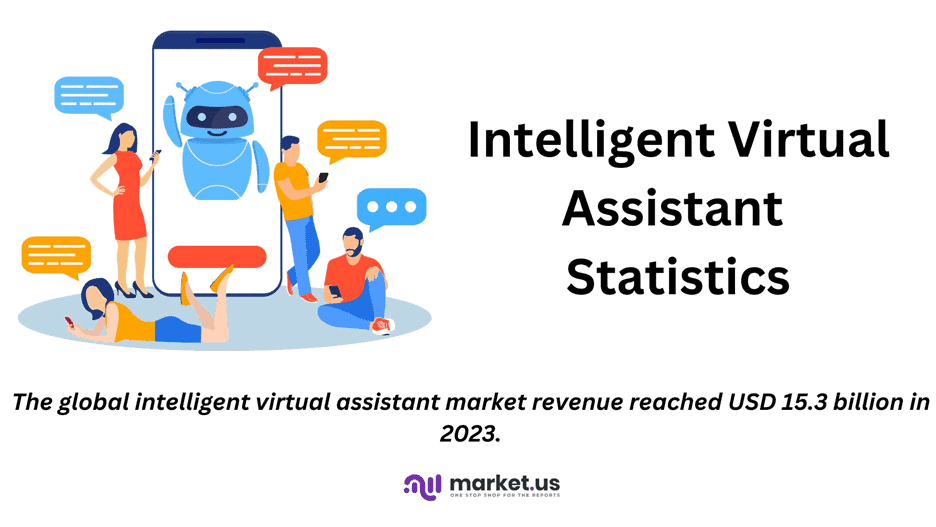
Editor’s Choice
- The global intelligent virtual assistant market revenue reached USD 15.3 billion in 2023.
- By 2033, the market is forecasted to reach an impressive USD 309.9 billion. Chatbots and smart speakers contributed USD 218.8 billion and USD 91.1 billion, respectively.
- Significant contributions from several key players characterize the market for intelligent virtual assistants. Apple Inc. leads the market with an 18% share.
- The global market for intelligent virtual assistants is dominated by North America, which holds a substantial 42.5% market share.
- Virtual assistants have gained significant traction across diverse sectors, with varying degrees of utilization. They play a central role in administrative work, being adopted by 37.7% of businesses.
- When asked about the perceived intelligence of various virtual assistants. 44% of respondents identified Alexa by Amazon as the most intelligent.
- By 2021, the estimated number of users of virtual digital assistants worldwide had risen to 1,831 million.
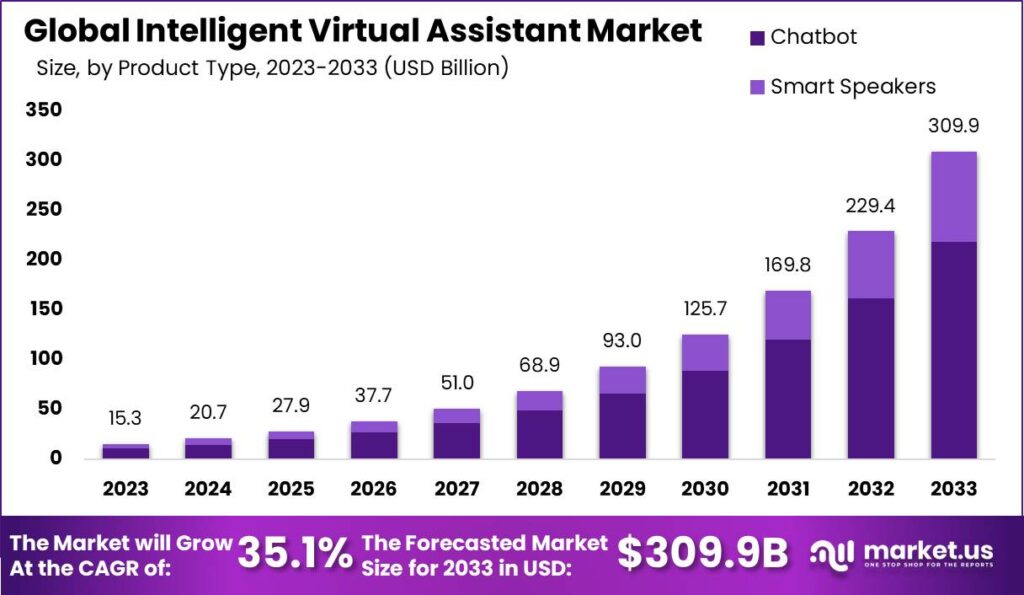
Intelligent Virtual Assistant Market Statistics
Global Intelligent Virtual Assistant Market Size Statistics
- The Global Intelligent Virtual Assistant Market has demonstrated significant growth over the years at a CAGR of 35.1%, starting from a revenue of USD 15.3 billion in 2023.
- This upward trajectory is expected to continue, with projected revenues reaching USD 20.7 billion in 2024 and USD 27.9 billion in 2025.
- By 2026, the market is anticipated to grow to USD 37.7 billion, further increasing to USD 51.0 billion in 2027.
- This growth trend continues, with the market projected to achieve USD 68.9 billion in 2028 and USD 93.0 billion in 2029.
- The forecast for 2030 shows a substantial rise to USD 125.7 billion, and by 2031, the market is expected to reach USD 169.8 billion.
- The rapid expansion is projected to culminate in a market revenue of USD 229.4 billion by 2032 and an impressive USD 309.9 billion by 2033.
- This growth highlights the increasing adoption and integration of intelligent virtual assistants across various sectors, driven by advancements in artificial intelligence and the rising demand for enhanced customer service experiences.
(Source: market.us)
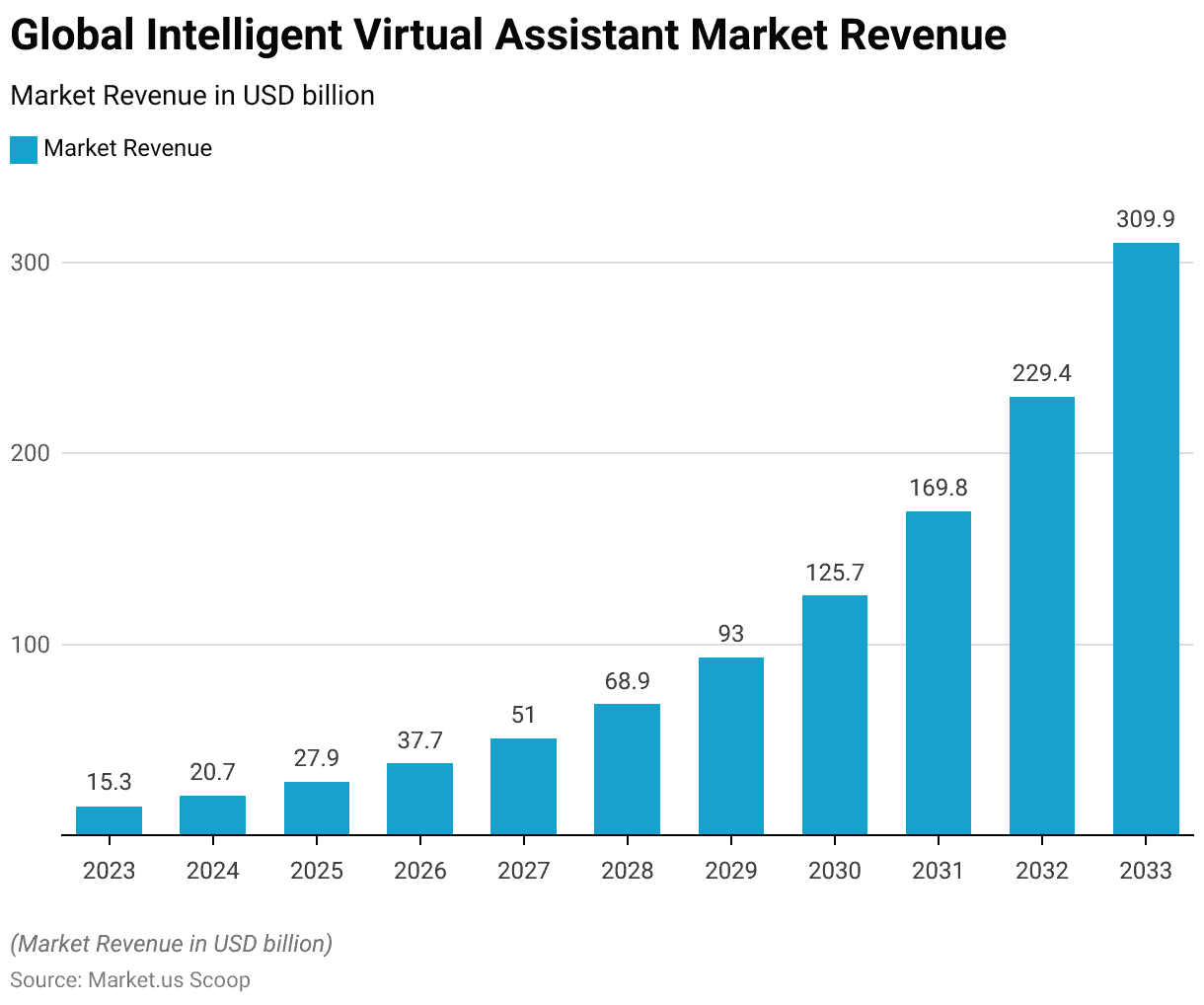
Global Intelligent Virtual Assistant Market Size – By Product Type Statistics
- The Global Intelligent Virtual Assistant Market is witnessing robust growth. Total market revenue is projected to escalate from USD 15.3 billion in 2023 to USD 309.9 billion by 2033.
- Within this market, the revenue from chatbots is expected to rise significantly from USD 10.8 billion in 2023 to USD 218.8 billion in 2033.
- Similarly, smart speakers are anticipated to see a substantial increase in revenue. Growing from USD 4.5 billion in 2023 to USD 91.1 billion by 2033.
- In 2024, the total market revenue is forecasted at USD 20.7 billion. With chatbots contributing USD 14.6 billion and smart speakers USD 6.1 billion.
- By 2025, these figures are expected to reach USD 27.9 billion, USD 19.7 billion, and USD 8.2 billion, respectively.
- The market is projected to continue its growth trajectory, with revenues in 2026 anticipated at USD 37.7 billion overall, USD 26.6 billion from chatbots, and USD 11.1 billion from smart speakers.
Intelligent Virtual Assistant Statistics More Insights
- In 2027, the total market revenue is expected to be USD 51.0 billion. Chatbots and smart speakers contributed USD 36.0 billion and USD 15.0 billion, respectively.
- The growth trend persists, with the market forecasted to reach USD 68.9 billion in 2028 (USD 48.6 billion from chatbots and USD 20.3 billion from smart speakers), USD 93.0 billion in 2029 (USD 65.7 billion from chatbots and USD 27.3 billion from smart speakers), and USD 125.7 billion in 2030 (USD 88.7 billion from chatbots and USD 37.0 billion from smart speakers).
- By 2031, the market is projected to grow to USD 169.8 billion, with chatbots generating USD 119.9 billion and smart speakers USD 49.9 billion.
- In 2032, the total market revenue is expected to be USD 229.4 billion, with chatbots contributing USD 162.0 billion and smart speakers USD 67.4 billion.
- Finally, by 2033, the market is forecasted to reach an impressive USD 309.9 billion, with chatbots and smart speakers contributing USD 218.8 billion and USD 91.1 billion, respectively.
- This growth underscores the increasing reliance on intelligent virtual assistants across various applications and industries.
(Source: market.us)
Take advantage of our unbeatable offer - buy now!


Competitive Landscape of the Global Intelligent Virtual Assistant Market Statistics
- Significant contributions from several key players characterize the market for intelligent virtual assistants.
- Apple Inc. leads the market with an 18% share, closely followed by 24/7 Customer Inc., holding a 17% share.
- Amazon.com Inc. and Nuance Communications Inc. each account for 9% of the market, while Baidu Inc. captures 10%.
- Google Inc. and Oracle Corporation both maintain an 8% market share.
- Microsoft Corporation and IBM Corporation contribute 7% and 6%respectively.
- The remaining 8% of the market is shared among other key players.
- This diverse distribution of market share highlights the competitive landscape of the intelligent virtual assistant industry, with numerous companies vying for dominance through innovation and technological advancements.
(Source: market.us)
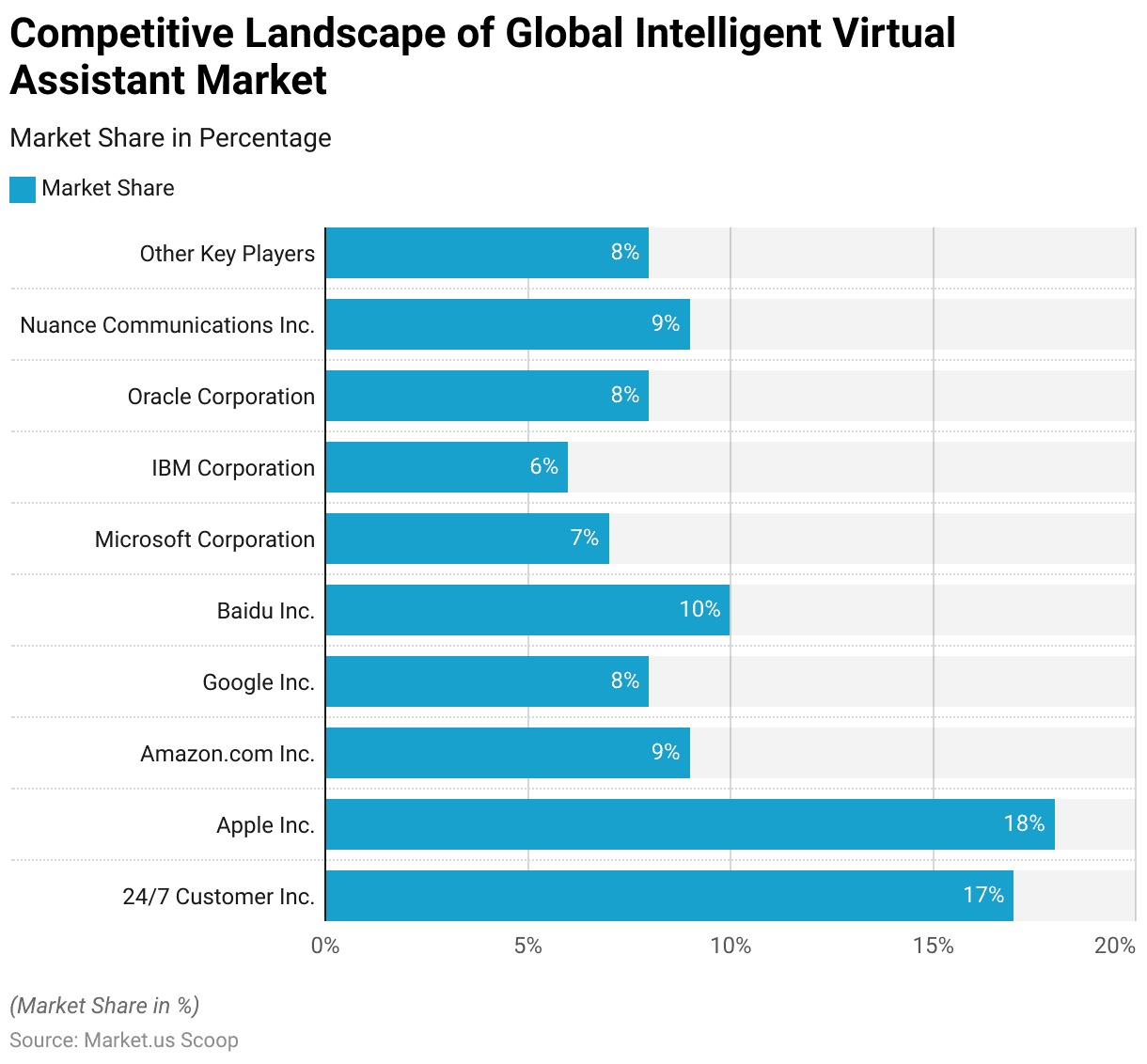
Regional Analysis of the Global Intelligent Virtual Assistant Market Statistics
- The global market for intelligent virtual assistants is dominated by North America, which holds a substantial 42.5% market share.
- The Asia-Pacific (APAC) region follows with a significant 26.3% share, reflecting its rapid technological adoption and expanding digital infrastructure.
- Europe accounts for 22.4% of the market, driven by strong industrial automation and advanced AI integration.
- South America and the Middle East & Africa (MEA) regions hold smaller shares, with 6.1% and 2.7%, respectively, indicating emerging opportunities for growth and development in these areas.
- This regional distribution underscores the varying levels of market penetration and technological advancement across different parts of the world.
(Source: market.us)
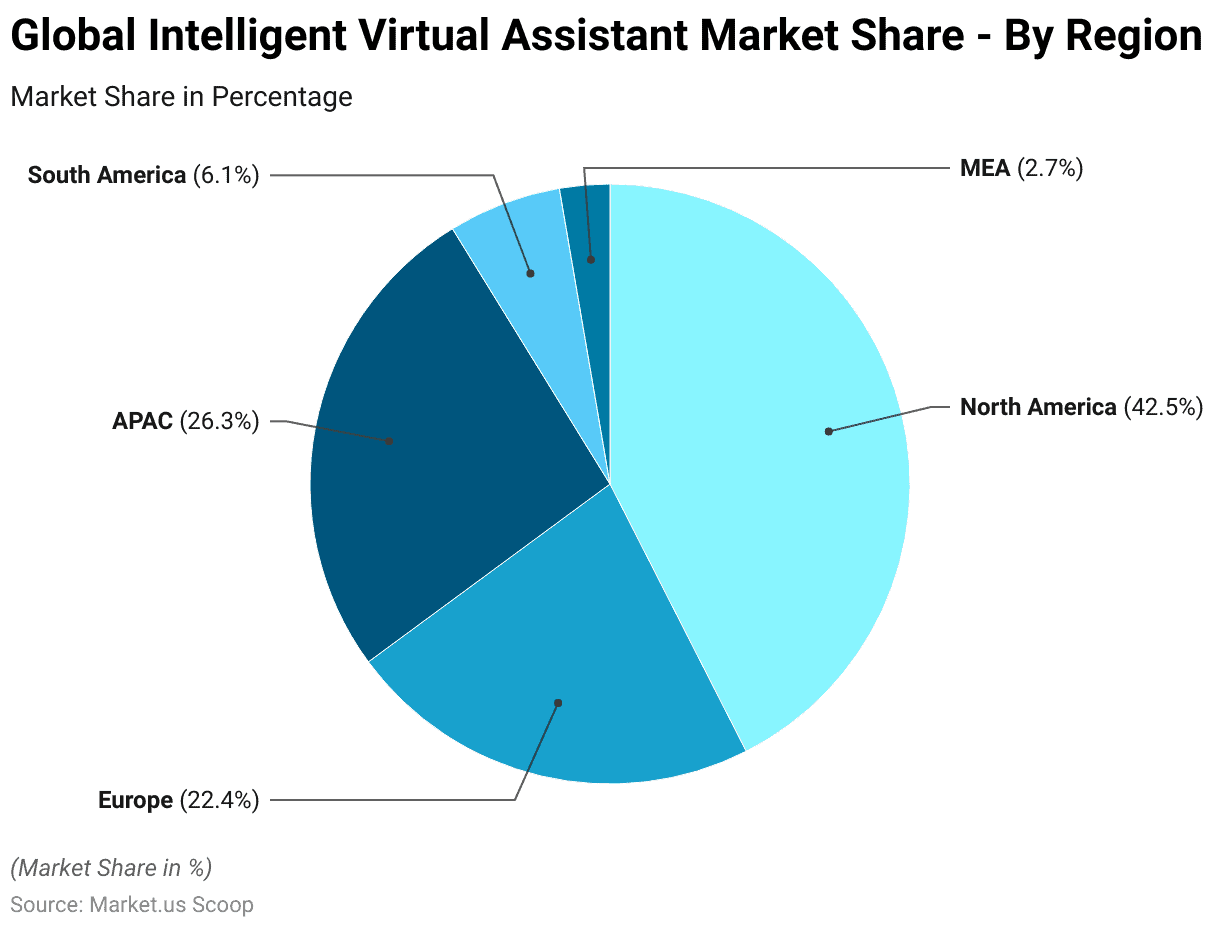
Top Businesses/Industries Utilizing Virtual Assistants
- Virtual assistants have gained significant traction across diverse sectors, with varying degrees of utilization. They play a central role in administrative work, being adopted by 37.7% of businesses.
- Their application extends to marketing, where they contribute to streamlined operations for 20.5% of entities.
- In sales and prospecting activities, these digital aids are employed by 14%, facilitating more efficient processes.
- Within the sphere of operations, a notable 9.7% of businesses rely on virtual assistants to enhance their workflows.
- In customer service, these tools have found a place in 6.3% of enterprises, bolstering interactions with clientele.
- Additionally, they assist in finance and bookkeeping tasks for 4.3% of businesses.
- Across a range of other sectors, virtual assistants are harnessed by 7.5% of organizations, showcasing their versatility and applicability in addressing diverse operational needs.
(Source: Virtudesk)

Perceived Intelligence of Virtual Assistant Statistics
- When asked about the perceived intelligence of various virtual assistants, 44% of respondents identified Alexa by Amazon as the most intelligent.
- Google Assistant followed with 33% of respondents rating it highly for intelligence. Siri by Apple was considered intelligent by 30% of respondents.
- Cortana from Microsoft was perceived as intelligent by 8% of respondents, while Samsung’s Bixby was favored by 5%.
- Other virtual assistants were considered the most intelligent by 3% of respondents.
- This data highlights Alexa and Google Assistant as leading in perceived intelligence among virtual assistants.
(Source: PC Magazine)

Most Used Intelligent Virtual Assistant Statistics
- Among the most used virtual assistants, Google Assistant leads, with 39% of respondents indicating its usage.
- Alexa by Amazon follows closely with 36%, while 29% of respondents use Siri by Apple.
- Notably, 21% of respondents do not use any of these virtual assistants.
- Cortana from Microsoft is used by 11% of respondents, and Samsung’s Bixby is utilized by 10%.
- Other virtual assistants account for 5% of usage among respondents.
- This data underscores the prominence of Google Assistant and Alexa in the virtual assistant market, with significant usage also observed for Siri.
(Source: PC Magazine)
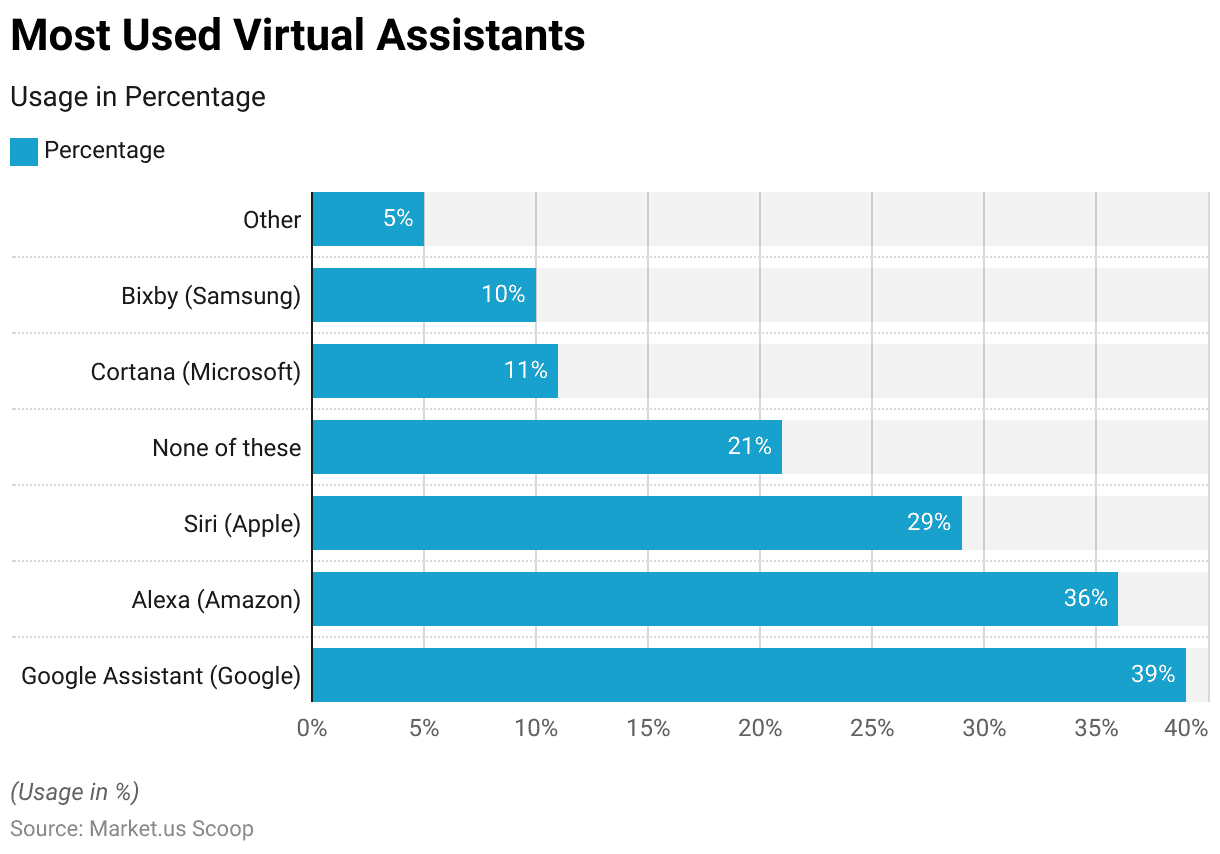
Number of Digital Voice Assistants in Use Worldwide
- The usage of digital voice assistants has seen remarkable growth worldwide. In 2019, approximately 3.25 billion digital voice assistants were in use.
- This number increased significantly to 4.2 billion in 2020, reflecting the growing adoption of voice-activated technology across various devices.
- The trend is expected to continue, with projections indicating that the number of digital voice assistants in use will double to 8.4 billion by 2024.
- This surge highlights the increasing integration of AI in voice assistants into daily life and various applications, driven by advancements in artificial intelligence and consumer demand for hands-free, intuitive interaction with technology.
(Source: Statista)

Number of Users of Intelligent Virtual Digital Assistant Worldwide
- The estimated number of virtual digital assistant users worldwide has shown a remarkable increase over the years.
- In 2015, there were approximately 390 million users, which grew to 504 million in 2016.
- This upward trend continued, reaching 710 million users in 2017 and surpassing the billion mark with 1,016 million users in 2018.
- The number of users further increased to 1,376 million in 2019 and 1,642 million in 2020.
- By 2021, the estimated number of users of virtual digital assistants worldwide had risen to 1,831 million.
- This data highlights the rapid adoption and widespread use of virtual digital assistants across the globe.
(Source: Statista)
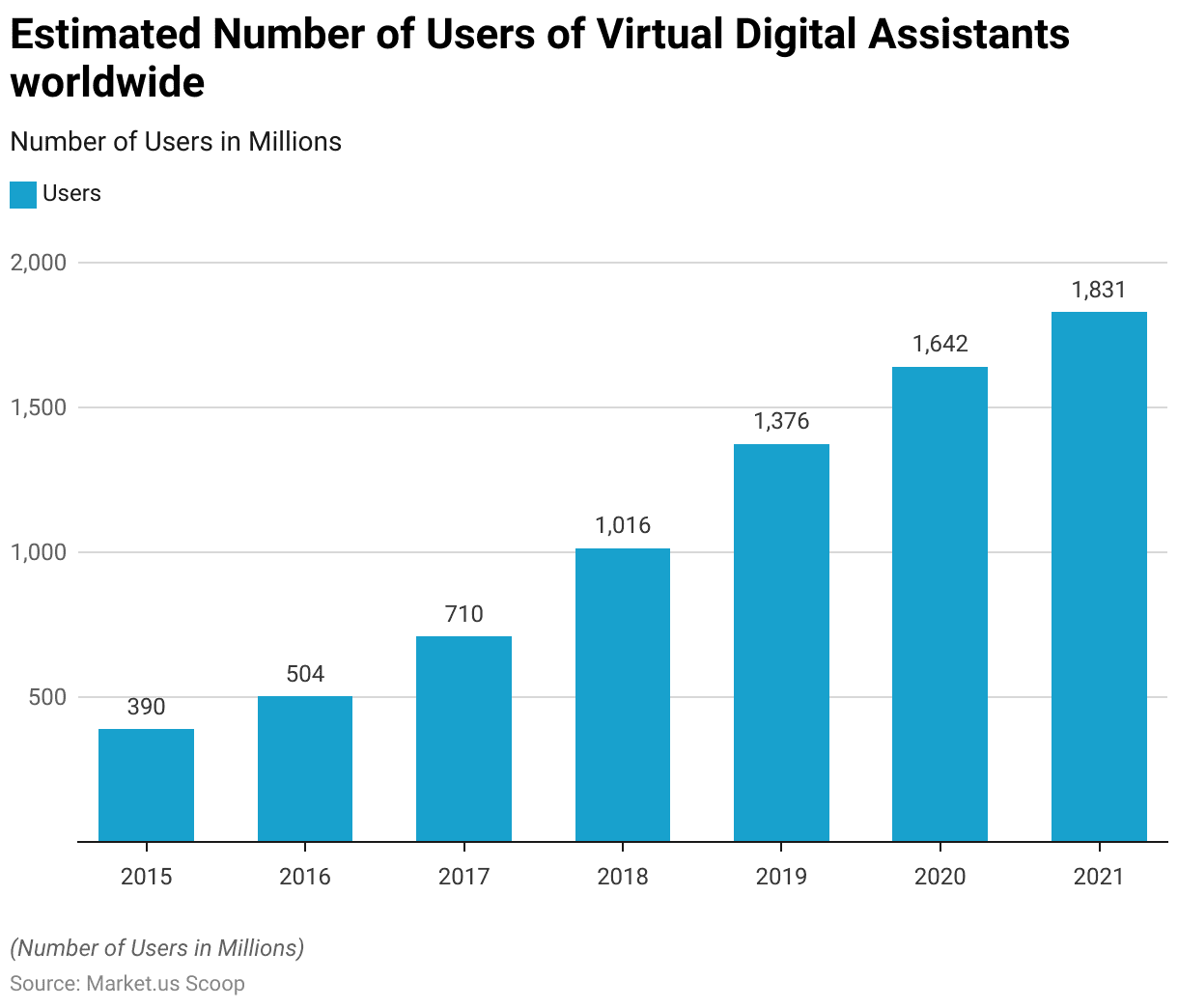
Distribution of Devices Used to Access Voice Intelligent Virtual Assistant Statistics
- The usage of voice assistants spans a variety of devices, with smart speakers being the most popular, as indicated by 93.30% of respondents.
- Smartphones are also widely used for accessing voice assistants, with 65.80% of respondents reporting usage.
- Connected cars represent another significant category, with 50.10% of respondents using voice assistants in their vehicles.
- Smart headsets are used by 27.50% of respondents, while computers account for 11.40% of voice assistant usage.
- TVs and smartwatches have the least usage, with 7.40% and 1.30% of respondents, respectively, accessing voice assistants through these devices.
- This distribution highlights the diverse range of devices through which consumers interact with voice assistant technology.
(Source: Softtek)
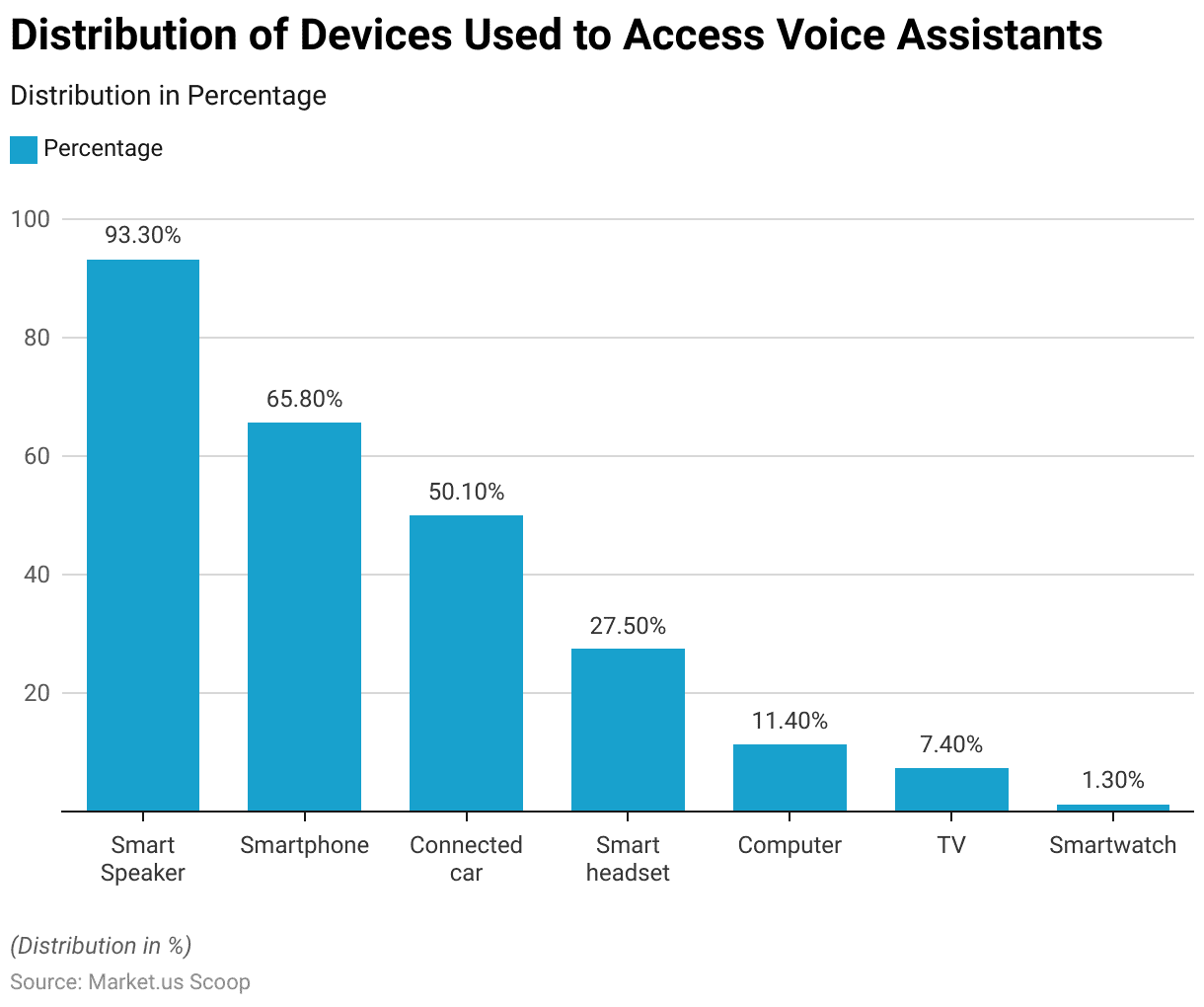
Utilization of Voice Assistants on a Smartphone
Usage of Voice Assistants on Smartphones for Various Activities
- Voice assistants on smartphones are used for a variety of purposes, with distinct patterns of engagement.
- For information inquiries, 86% of users test this function, while 52% use it monthly.
- Traffic or directions are sought by 70% of users during tests and by 47% every month.
- Searching for a place to eat involves 55% of users in tests and 28% monthly.
- Product searches engage 41% of users in tests and 24% monthly.
- Music is accessed by 41% of users in tests and 20% monthly.
- Games are played by 26% of users in tests and 14% every month.
- Radio is listened to by 21% of users in tests and 13% monthly. While podcasts are accessed by 20% of users in tests and 11% monthly.
- This data highlights the varied applications of voice assistants on smartphones. With information inquiries and traffic directions being the most frequently used functions.
(Source: Softtek)
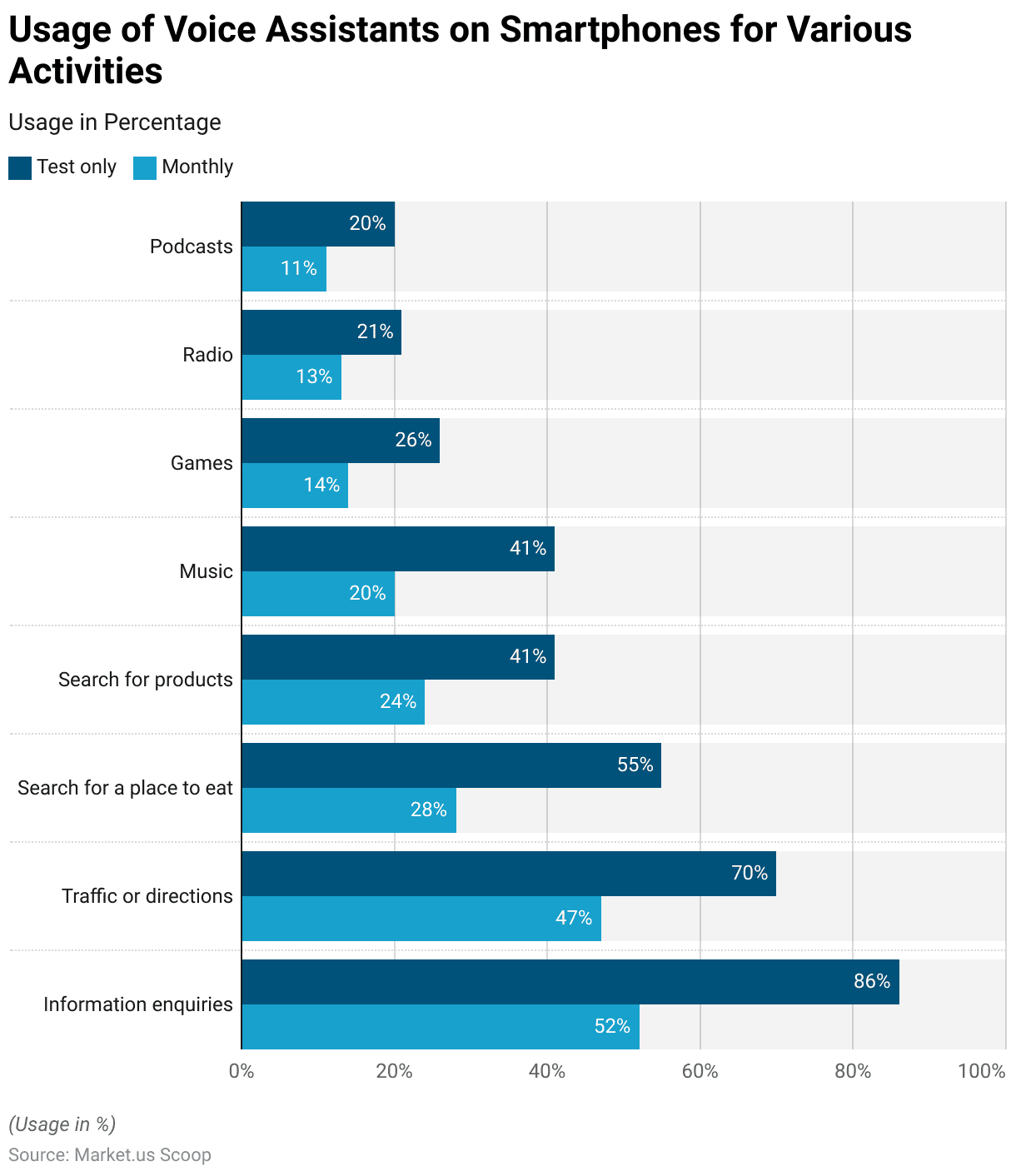
Productive Uses of Smartphone Voice Assistants
- Smartphone voice assistants are employed for various productive uses, with different levels of engagement.
- Making calls is a primary function, with 66.6% of users testing this feature and 44.1% using it monthly.
- Voice text messaging is another popular use, tested by 57.2% of users and utilized monthly by 39.8%.
- Setting alarms is tested by 48.8% of users, with 31.6% using it regularly.
- Checking the time involves 46.9% of users in tests and 31.0% every month.
- Opening apps are tested by 34.7% of users and used monthly by 21.0%.
- Consulting the calendar is done by 32.9% in tests and 22.0% monthly.
- Controlling the smartphone sees 18.0% of users in tests and 11.9% using it regularly. Performing banking transactions is tested by 14.6% of users, with 10.8% engaging in this activity monthly.
- This data illustrates the diverse, productive applications of voice assistants on smartphones, with calling and voice text messaging being the most frequently utilized functions.
(Source: Softtek)
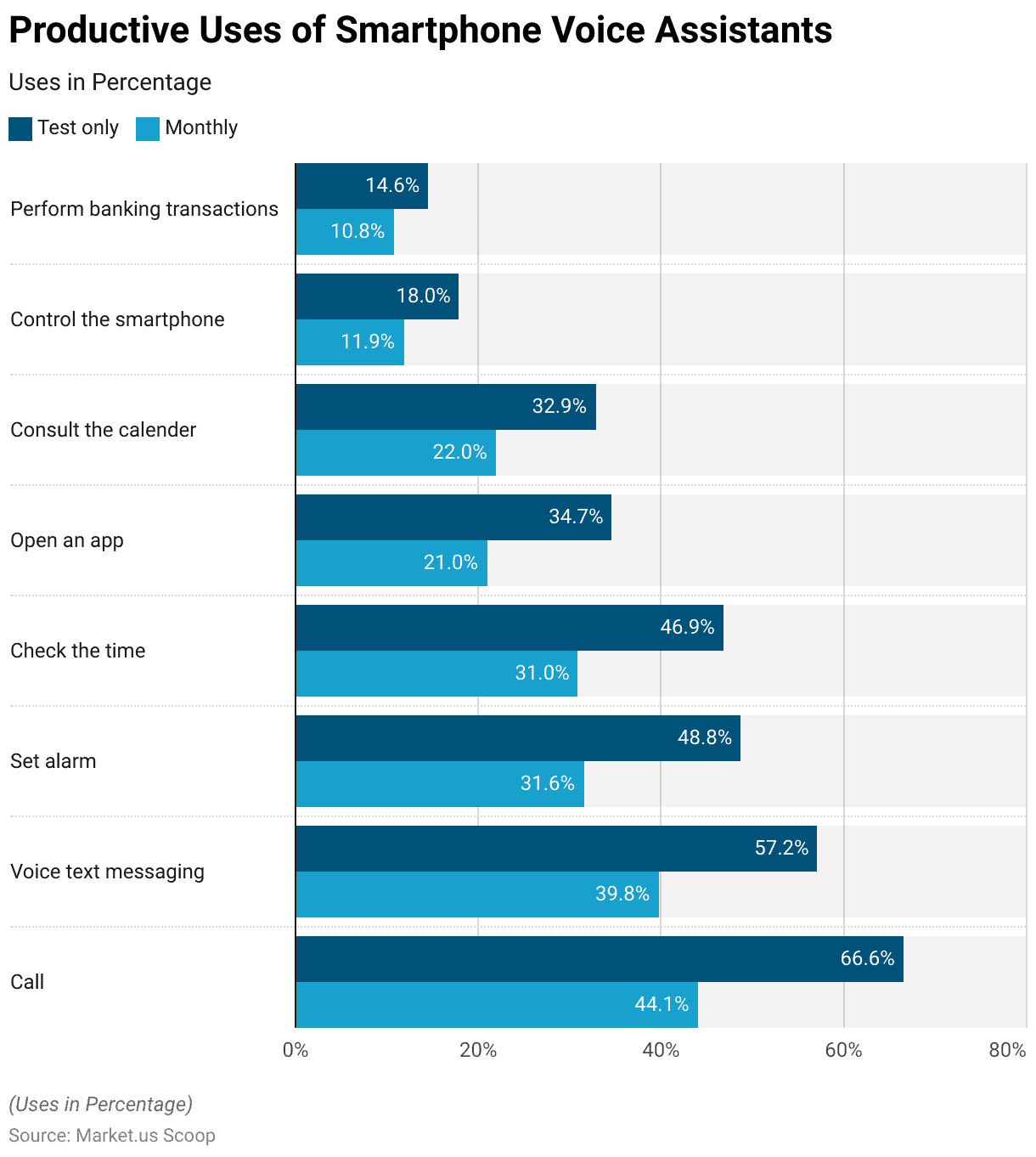
Demographics of Virtual Assistant Users
Age Group
- Virtual assistant usage spans various age groups, revealing distinct patterns of adoption.
- Among individuals aged 18 to 29, 28% actively employ virtual assistants, showcasing their prevalence among younger demographics.
- Similarly, in the 30 to 39-year bracket, 32% of respondents engage with virtual assistants, indicating a continued usage trend.
- Meanwhile, the 40 to 49-year age group and those aged 50 and above exhibit equal usage levels at 20%, suggesting a consistent appeal that transcends generational divides.
- This data highlights that virtual assistants are widely adopted across all age groups, with particularly high usage among those aged 18 to 39.
(Source: Survey for Characteristics and Usage Patterns of Smart Voice Assistants for Shopping Purposes Among Jordanian Consumers)
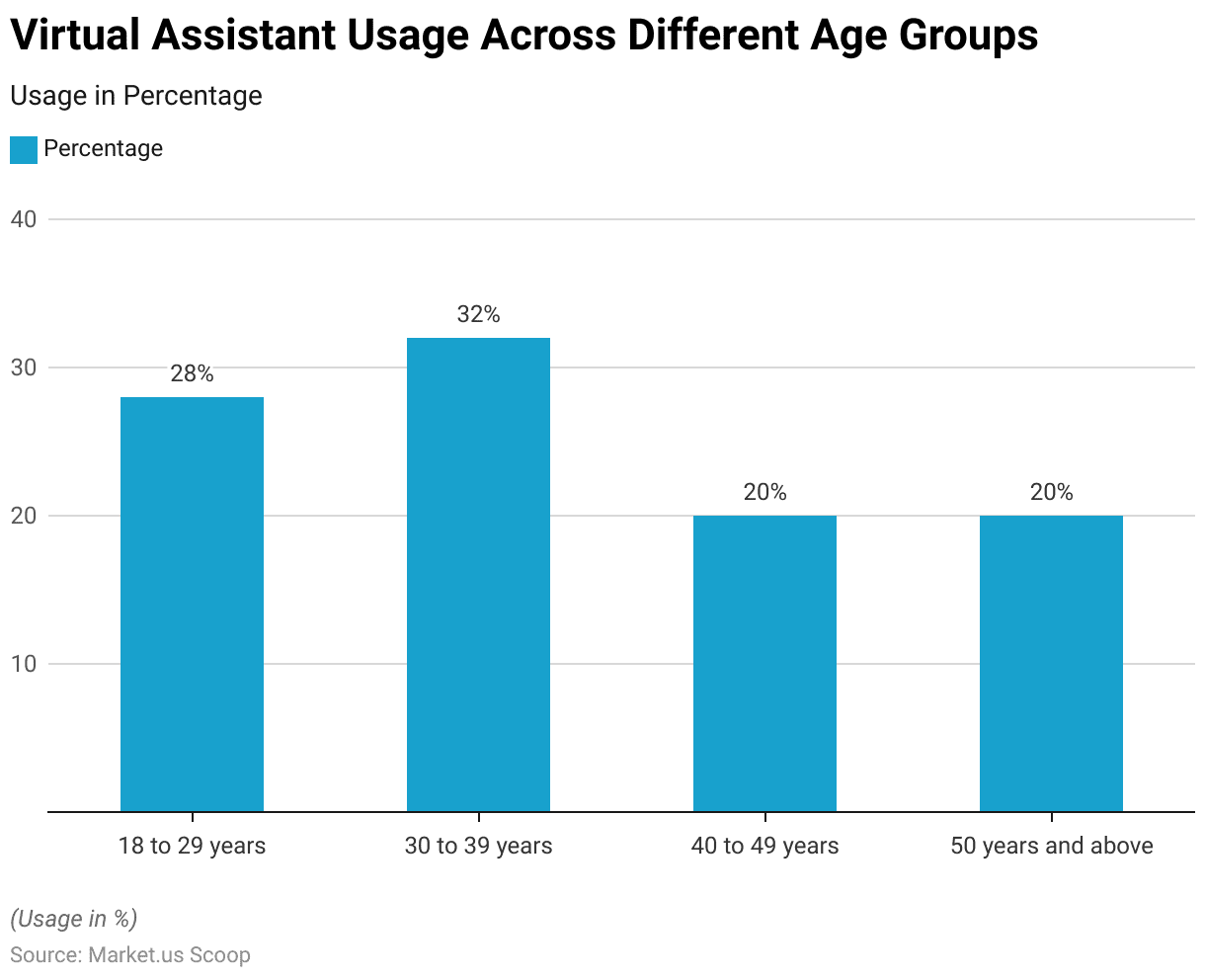
Gender
- Utilizing virtual assistants demonstrates a balanced gender distribution, as survey responses indicate.
- Among the respondents, 51% identify as female, while the remaining 49% identify as male.
- This data highlights an almost equal adoption rate of virtual assistants among both genders, suggesting that the technology appeals broadly across gender lines.
(Source: Survey for Characteristics and Usage Patterns of Smart Voice Assistants for Shopping Purposes Among Jordanian Consumers)
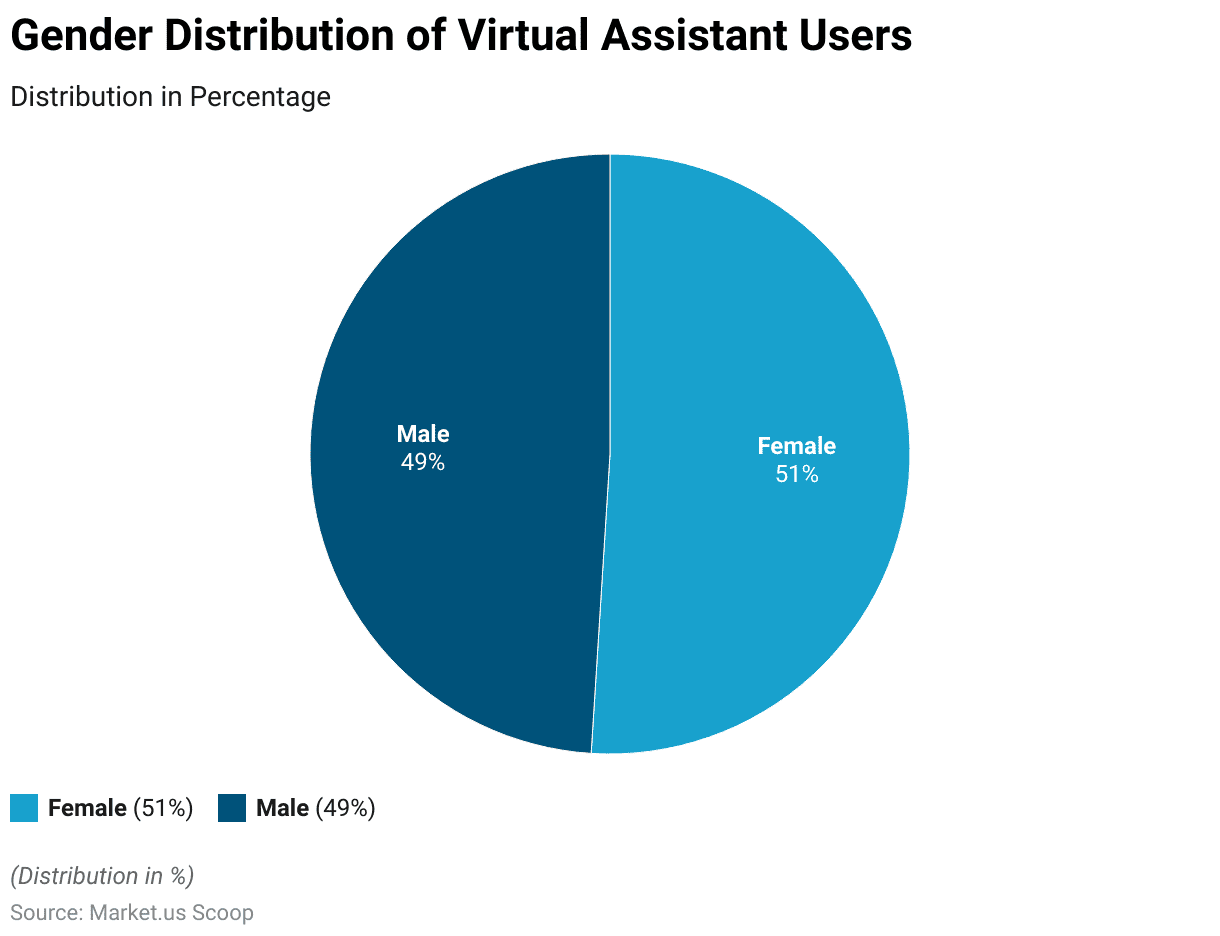
Educational Qualification
- Virtual assistant usage correlates with varying academic qualifications, reflecting nuanced preferences across educational backgrounds.
- Respondents with a high school diploma represent 17% of virtual assistant users, showcasing their engagement among individuals with foundational education.
- Of those holding a bachelor’s degree, 29% actively utilize virtual assistants, indicating a higher propensity for adoption among this cohort.
- Virtual assistant usage remains prominent even among individuals with higher academic attainments; 23% of those with master’s degrees engage with these tools, while 12% of respondents possessing a Ph.D. or higher qualifications also partake in their usage.
- This data highlights that virtual assistants are utilized across a spectrum of educational backgrounds, with notable adoption among those with bachelor’s and master’s degrees.
(Source: Survey for Characteristics and Usage Patterns of Smart Voice Assistants for Shopping Purposes Among Jordanian Consumers)
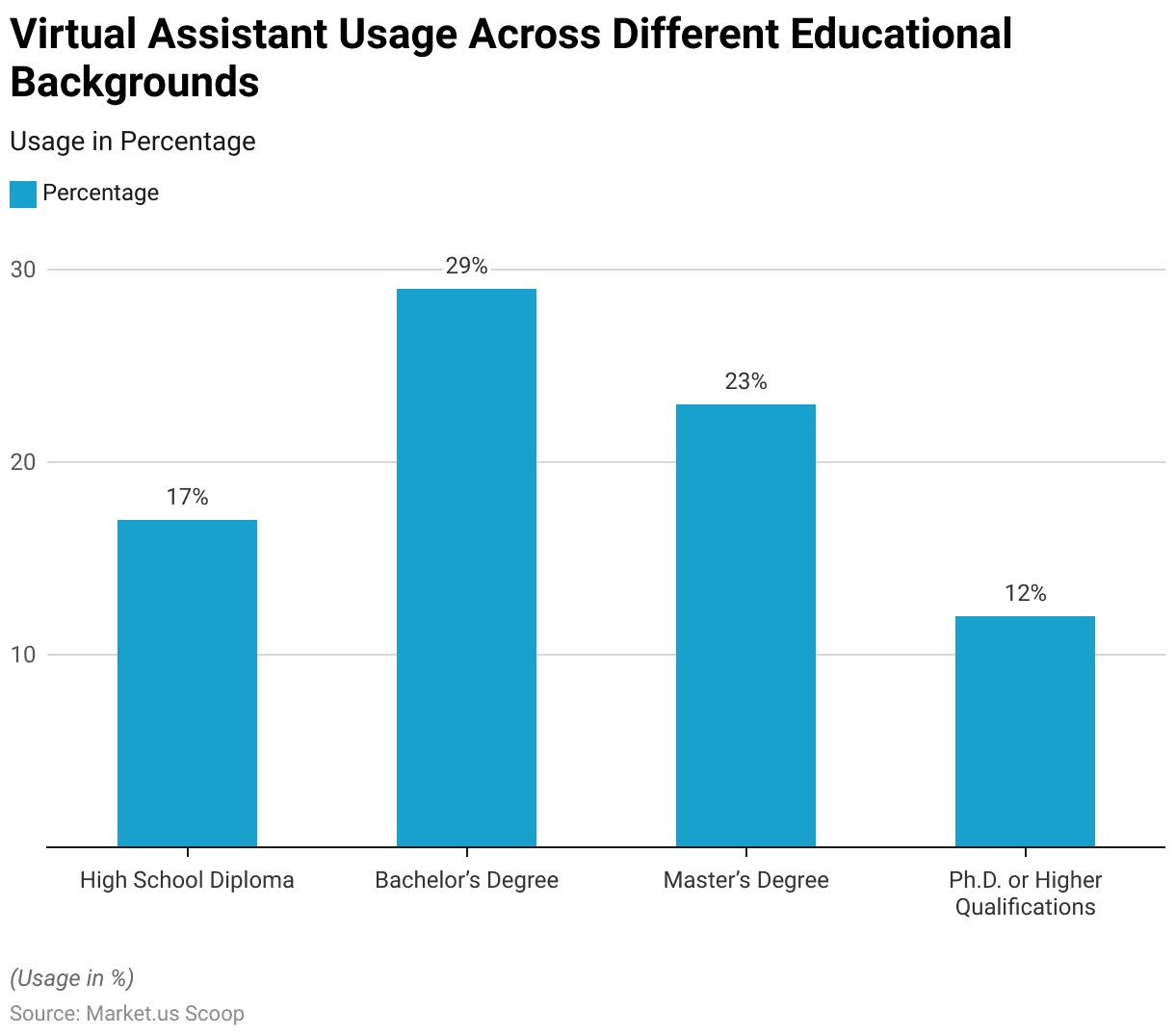
Voice Capabilities Provided by Utility Companies
- Utility companies today offer a range of voice capabilities through skills or actions, enhancing customer engagement and service.
- Account balance inquiries are supported by 46% of utilities, making it the most commonly offered feature.
- Efficiency tips and utility contact information are each provided by 38% of utilities.
- The ability to make payments via voice commands is available from 23% of companies.
- Information on the source of electricity generation, outage status updates, and outage notifications are each offered by 15% of utilities.
- Additionally, 8% of utilities provide smart home device control capabilities.
- This array of features underscores the growing integration of voice technology in utility services aimed at improving customer convenience and operational efficiency.
(Source: E Source)
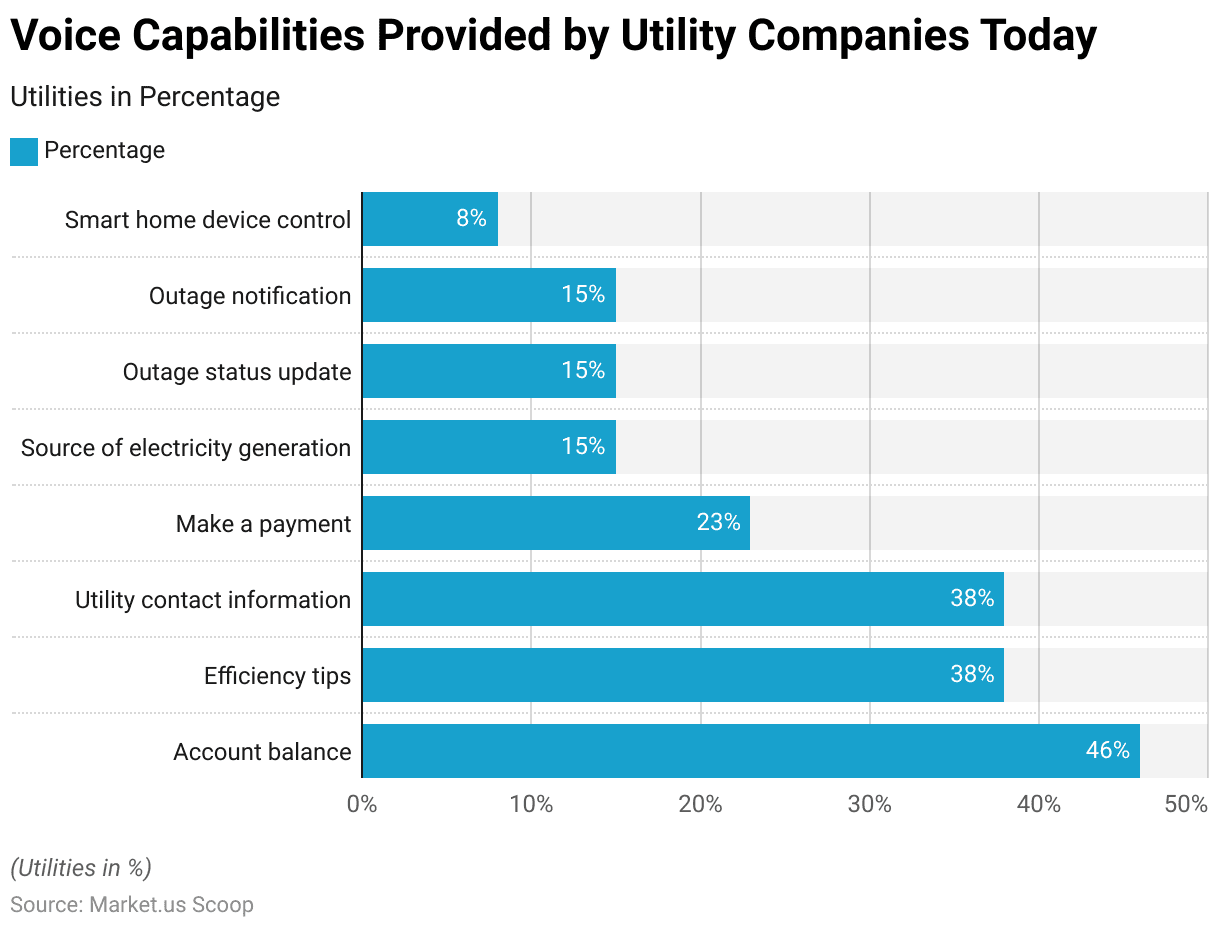
Voice Assistant Users and Penetration
- Voice assistant usage in the U.S. has seen substantial growth over the years, with user numbers and market penetration increasing significantly.
- In 2018, there were 103.9 million voice assistant users, marking a 30.20% increase from the previous year, representing 31.70% of the population.
- By 2019, the number of users rose to 115.2 million, a 10.80% increase, covering 34.90% of the population.
- In 2020, the user base expanded to 128.0 million, an 11.10% increase, reaching 38.50% of the population.
- The growth continued into 2021 with 132.0 million users, a 3.20% increase, representing 39.40% of the population.
- By 2022, the number of voice assistant users in the U.S. reached 135.6 million, a 2.70% increase, accounting for 40.20% of the population.
- This data highlights the steady rise in the adoption and penetration of voice assistants among the U.S. population over the years.
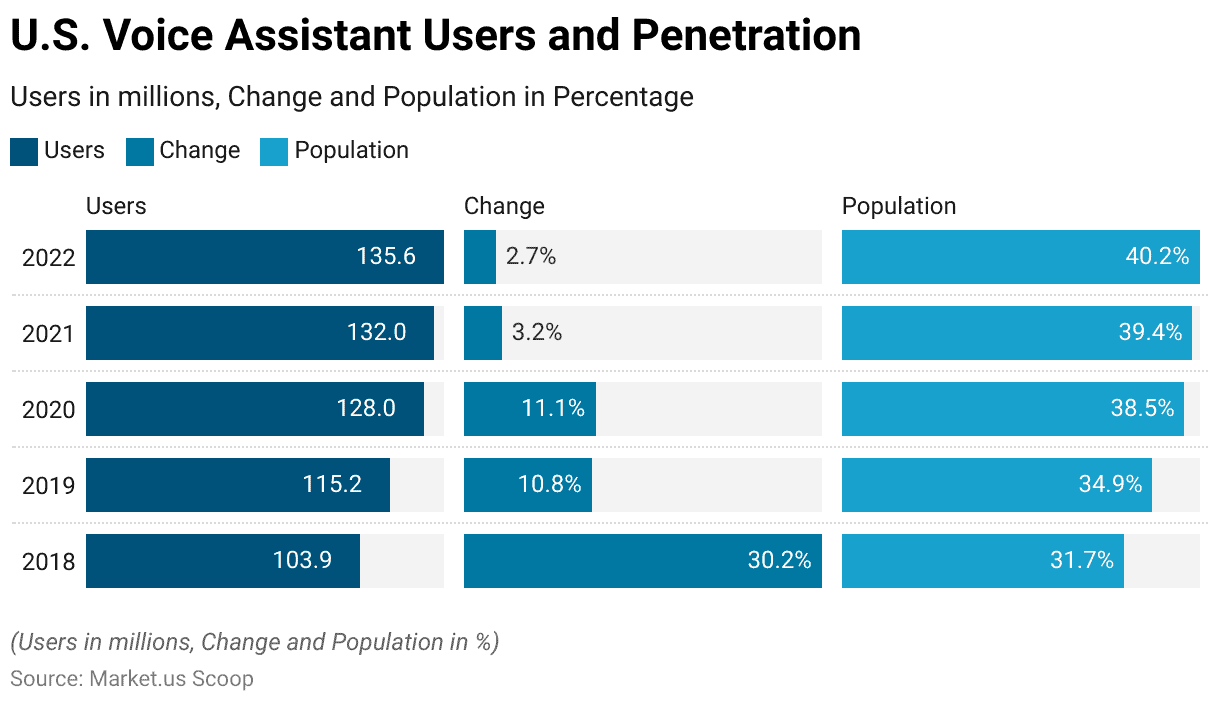
Adoption of Virtual Assistant in Homes
- Virtual assistants have established a significant presence in home equipment, as survey responses indicate their adoption across various categories.
- Notably, 58% of respondents reported utilizing virtual assistants with televisions, showcasing their integration into entertainment systems.
- Lighting control follows closely, with 36% of participants employing virtual assistants to manage lights, highlighting their role in enhancing home ambiance.
- Regarding environmental control, 29% of respondents utilize virtual assistants to regulate thermostats, contributing to energy efficiency.
- Additionally, 26% have integrated virtual assistants into alarm systems for enhanced security measures.
- The utilization extends to outlets and switches (22%), underscoring their role in home automation.
- Even small smart appliances witness virtual assistant usage at 19%, streamlining daily tasks.
- Virtual assistants also find a place in ensuring home security, with 18% using them to manage locks and garage doors.
- Lastly, 16% have integrated virtual assistants into doorbell systems, exemplifying their diverse applications across various facets of home equipment.
(Source: PwC Consumer Intelligence Series Voice Assistants Survey 2018)
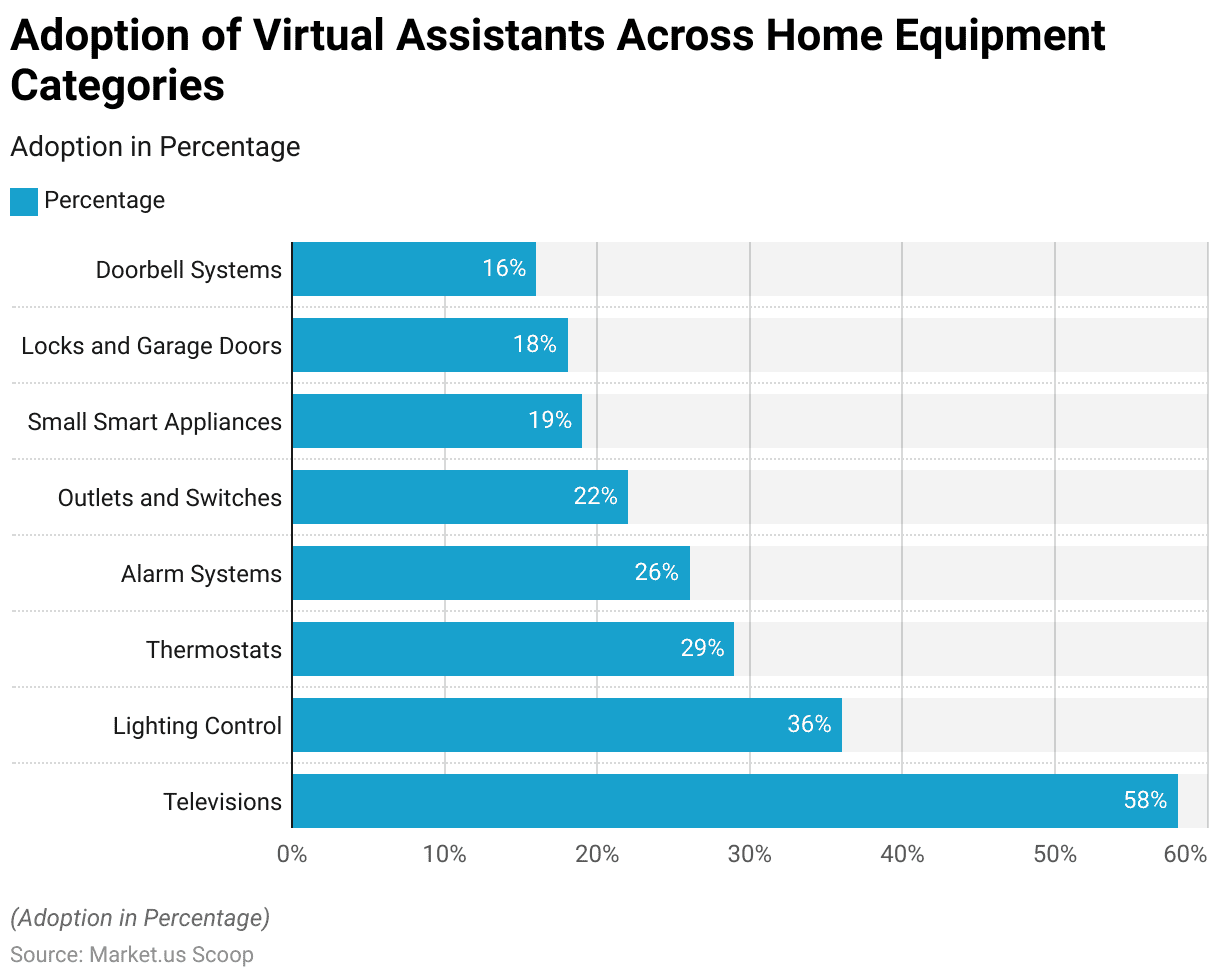
Top Virtual Assistants and Their Usage Along with Specifications
Amazon Alexa
- According to the latest data, approximately 68.2% of smart speaker users in the US prefer Amazon Echo, a device powered by Alexa, which has marked a slight 1.5% decrease from 2020.
- Amazon Alexa led the global smart speaker market with a share exceeding 21.7% in 2019.
- The platform now supports over 100,000 smart home devices, a 40% increase from 2019‘s 60,000.
- Alexa’s appeal spans various age groups: 18-24-year-olds engage at least at 19%, while 25-34-year-olds show higher usage at 29%.
- Middle-aged and older users (35-54+ years) represent the majority, indicating Alexa’s broad appeal across different age demographics.
(Source: Earthweb)
Apple Siri
- Apple claims that Siri is used by 500 million people globally, though the frequency of usage—whether daily or monthly—is unspecified.
- Despite 98% of smartphone users having tried Siri, many do not consistently use it, likely due to its introduction starting from the iPhone 4S, leading to initial curiosity rather than regular use.
- In a 2017 survey of US adults, 9% reported using Siri multiple times daily, while 65% did not use it at all.
- By January 2019, 47% of respondents were highly satisfied with Siri’s functionality.
- Siri on the HomePod achieved 99.4% accuracy in understanding queries, credited to advanced noise cancellation.
- Loup Ventures’ analysis shows Siri’s precision significantly improved from 52.3% in 2017 to undisclosed levels by 2018.
(Source: Voiceseo, Statista, Voiceseo, 2018 Loop Ventures Survey)
Google Assistant
- Currently, Google Assistant leads the market with a 46% share, expected to exceed 60% by 2022.
- The number of Google Assistant apps grew steadily, from 165 in April 2017 to 1,719 by January 2018.
- By 2022, Google Assistant had 81.5 million users, with Siri close behind at 77.6 million and Alexa at 71.6 million.
- As of 2024, Google Assistant’s user base expanded to 88.8 million, while Siri reached 84.2 million and Alexa grew to 75.6 million.
- These figures highlight the significant role of voice assistants in daily technology interactions.
(Source: Voicebot.ai)
Intelligent Virtual Assistant Salary Statistics
- The annual salaries for virtual assistants (VAs) in the U.S. are wide, reflecting the diversity in job roles and experience levels.
- Approximately 15% of VA jobs fall within the $15,000 to $25,499 salary range, while 15.50% are in the $25,500 to $35,999 range.
- Salaries between $36,000 and $46,499 account for 12% of jobs.
- In the $46,500 to $56,999 range, 6% of jobs are represented, and 5% of positions offer salaries between $57,000 and $67,499.
- The $67,500 to $77,999 salary range comprises 8% of jobs, while 6% of VA roles have salaries between $78,000 and $88,499.
- Positions with annual salaries from $88,500 to $98,999 and from $99,000 to $109,499 each account for 5% and 15% of jobs, respectively.
- Finally, 5% of VA positions offer salaries between $109,500 and $119,999, and 3% fall within the $120,000 to $130,500 range.
- This distribution highlights the varied earning potential for virtual assistants in the U.S.
(Source: ZipRecruiter)
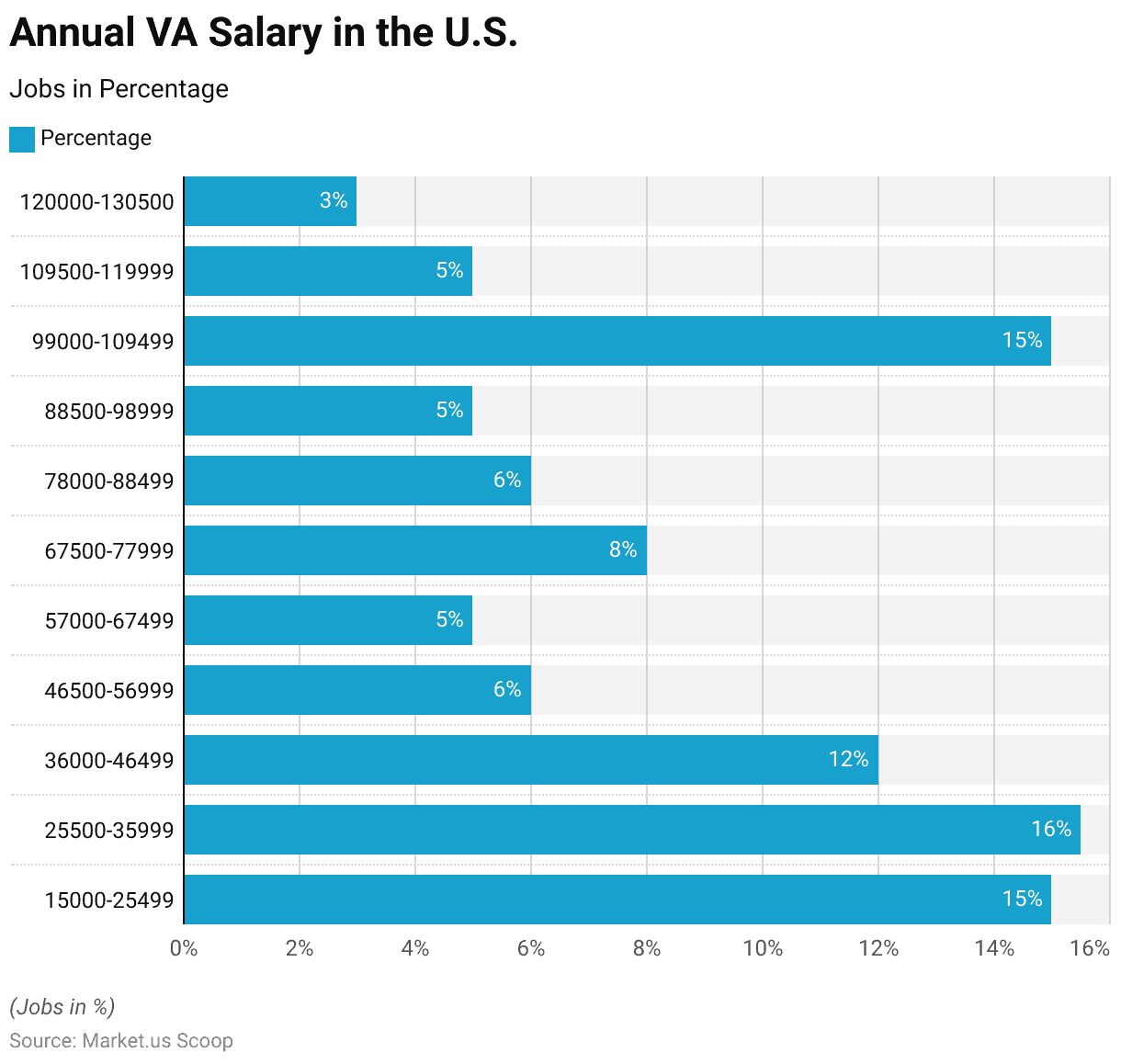
Consumer Adoption and Preferences
- In a survey by PwC involving 1,000 U.S. individuals aged 18 to 64, 10% were unfamiliar with voice-enabled devices and products.
- Of the 90% who were aware of such technology, 72% had used a voice assistant.
- The primary drivers of this adoption were younger consumers, households with children, and those earning over $100,000 annually.
- Despite the widespread availability of voice assistants, 74% of users primarily utilize their mobile voice assistants at home.
- Most focus group participants preferred the privacy of home use and felt socially awkward using voice assistants in public. This may explain the lower usage among 18 to 24-year-olds, who spend more time outside their homes.
- Half of the survey respondents have used voice assistants for purchases, with an additional 25% willing to do so in the future. Items bought via voice assistants are usually small and practical, not requiring physical inspection. Positive shopping experiences can enhance loyalty, trust, and spending.
- On average, 80% of consumers who have shopped using voice assistants report satisfaction.
(Source: PwC Consumer Intelligence Series Voice Assistants Survey 2018)
Advantages and Disadvantages
- 90% percent of users have shared their positive experiences with friends and family, and an equal percentage have made repeat purchases with the same retailer.
- Additionally, 36% have developed a more favorable view of the retailer, and 24% have increased their spending with them. However, distrust remains a significant issue.
- One in four consumers would avoid using their voice assistant for shopping, both now and in the future.
- Specifically, 46% are hesitant because they doubt the voice assistant’s ability to accurately understand and process orders, while 45% are uncomfortable or lack trust in transmitting payments through their voice assistant.
(Source: PwC Consumer Intelligence Series Voice Assistants Survey 2018)
Recent Developments
Acquisitions:
- IBM’s Acquisition of MyInvenio: In April 2021, IBM acquired MyInvenio, a process mining software company. This acquisition enhances IBM’s AI-powered automation capabilities and strengthens its IVA offerings by integrating process mining technology to help organizations streamline business processes.
- Microsoft’s Acquisition of Nuance Communications: In March 2022, Microsoft completed its acquisition of Nuance Communications for $19.7 billion. Nuance is known for its conversational AI and clinical intelligence solutions, which will bolster Microsoft’s IVA capabilities, particularly in the healthcare sector.
New Product Launches:
- Amazon’s Alexa Smart Properties: In 2023, Amazon launched Alexa Smart Properties, designed to help senior living communities and healthcare providers offer personalized and automated care using Alexa devices. This service aims to improve patient engagement and operational efficiency.
- Google’s Duplex on the Web: Google introduced Duplex on the Web, an extension of its Duplex AI technology, which allows users to automate complex tasks such as booking appointments and filling out forms directly through Google Assistant.
Funding:
- Avaamo’s Series B Funding: Avaamo, a provider of conversational AI solutions, secured $14.2 million in Series B funding in January 2023. The funding will be used to expand its IVA solutions across various sectors, including healthcare, finance, and customer service.
Market Growth:
- Global Market Expansion: The growth is driven by the increasing adoption of AI-driven virtual assistants across various industries.
- Regional Insights: North America held the largest market share in 2022, driven by the high adoption rate of smart speakers and AI technologies. The Asia-Pacific region is expected to witness the fastest growth due to the rising adoption of smart devices and increasing investments in AI technology.
Innovation and Trends:
- Integration with AI and Machine Learning: Companies are integrating advanced AI and machine learning capabilities into their IVAs to enhance functionalities such as natural language understanding, personalized responses, and predictive analytics.
- Multi-Language Support: The development of multi-language support in IVAs is expanding their market reach, allowing them to cater to a more diverse global audience.
- Enhanced Customer Service: The use of IVAs in customer service is growing, with companies deploying these assistants to handle inquiries, provide personalized recommendations, and streamline customer interactions across digital channels.
Conclusion
Intelligent Virtual Assistant Statistics – Intelligent Virtual Assistants (IVAs) are revolutionizing technology by providing seamless interaction and enhanced user experiences across personal and professional settings.
Leading companies like Amazon, Google, Apple, Microsoft, and Samsung offer diverse capabilities, making tasks such as scheduling, customer service, and smart home control more efficient.
Despite security and privacy concerns, the future of IVAs is promising with advancements in natural language processing, personalization, and integration.
As IVAs evolve, they will become even more indispensable, transforming everyday tasks and driving innovation in the digital age.
FAQs
An Intelligent Virtual Assistant (IVA) is a software agent that can perform tasks or services for an individual based on commands or questions. These assistants utilize natural language processing and machine learning to provide personalized responses and automate various functions.
IVAs work by processing user inputs, typically voice or text, and using artificial intelligence algorithms to understand the request. They then access relevant information or perform the requested task, providing feedback to the user in a conversational manner.
Common uses of IVAs include setting reminders, answering questions, providing customer support, controlling smart home devices, playing music, making reservations, and performing online searches.
The benefits of using an IVA include increased efficiency, 24/7 availability, the ability to handle multiple tasks simultaneously, personalized user experiences, and hands-free operation for various tasks.
Leading companies in the IVA market include Amazon (Alexa), Google (Google Assistant), Apple (Siri), Microsoft (Cortana), and Samsung (Bixby).
Discuss your needs with our analyst
Please share your requirements with more details so our analyst can check if they can solve your problem(s)



